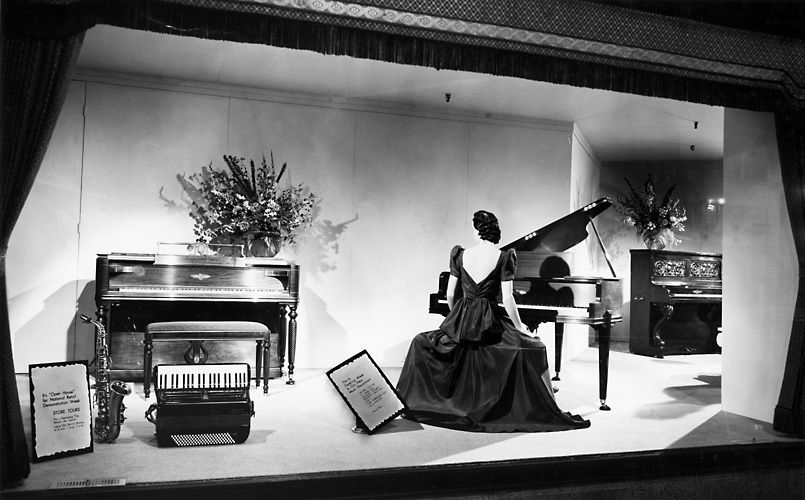This article was scraped from Rochester Subway. This is a blog about Rochester history and urbanism has not been published since 2017. The current owners are now publishing link spam which made me want to preserve this history.. The original article was published August 12, 2012 and can be found here.
![A Sibleyd's department store window display featuring a mannequin seated at a piano, a second piano, a saxophone and an accordion. (1940). [IMAGE: Rochester Public Library]](https://senseofplace.dev/content/images/photos/rochester-sibleys-window-instruments.jpg)
The Atlantic Cities

blog recently posted a map of U.S. cities with the highest concentration of musicians per capita. It probably surprised many people to see that Rochester ranked #9, immediately behind cities like Las Vegas, Portland, and New Orleans. But Rochester has a long history of music making. Remember Cab Calloway, Chuck Mangione, Eastman School of Music, the House of Guitars... We even have our own Rockin Rochester U.S.A.

surf tune. Amazing!
![It probably surprised many people to see that Rochester ranked #9 on Atlantic Cities' list of most musical U.S. cities, immediately behind Las Vegas, Portland, and New Orleans. [IMAGE: The Atlantic Cities Blog]](https://senseofplace.dev/content/images/photos/most-musical-cities-usa.jpg)
In fact, Rochester has been a musical city almost from its beginnings. I want to share with you an interesting little record album recently pulled from a pile at a Goodwill thrift store. It's a collection of songs and piano pieces from the mid 1800's to early 1900's titled "Take Me Back To Old Rochester." Most of these charming compositions were written by Rochesterians or composers who spent some time or trained here. Others, while not written by Rochesterians, make mention of some popular aspect of our town and are worth a listen...
![This group is gathered around a piano to perform for a WHAM radio broadcast (c.1927). The microphone is at far left. Identified are: 4th from left, Florence Knope Freeman; far right, Clayton Knope; at piano, James Quillian. [IMAGE: Albert R. Stone Negative Collection]](https://senseofplace.dev/content/images/photos/rochester-wham-radio-show.jpg)
We begin with a turn-of-the-century standard, "Come, Josephine in My Flying Machine" from 1910, the year the first airplane flew over Rochester. That same year, Rochesterian Blanche Stewart Scott became America's first woman pilot, and "sky kid" Glenn Curtiss's "Jenny" airplane helped turn nearby Hammondsport into a World War I boom town.
"Rochester Maid Means Quality" was the boast of the 1910 Industrial Exposition, a yearly fair of local industries: clothing, shoes, cameras, patent medicines. Florence Newell Barbour (wife of the first president of Colgate-Rochester Divinity School) and lyricist Kendrick Shedd, punning on this slogan, also gave the 1910 Rochester Girl her due.
Edgar Sherwood (d. 1919) was a local society piano teacher, music publisher, and certaintly Rochester's finest composer of salon music during the nineteenth century. His "Rochester Semi-Centennial March" (1884) celebrated Rochester's 50th birthday; "Amid Bright Blooms (1876) is a "Mazurka Elegante" dedicated to the Misses Jennie and Fannie Rochester, descendents of Colonel Nathaniel Rochester, the city's founder.
One of the most important figures in early American Music was an Englishman - Henry Russell (1812-1900), the immensely successful composer and performer of "A Life on the Ocean Wave," "Woodman, Spare That Tree" and many others. He lived for eight years in Rochester, as organist of First Presbyterian Church. More operatic scena than popular song, Russell's "Slave Sale" dramatically reminds us that Rochester was an abolitionist stronghold, the home of Frederick Douglas, and a stop on the underground railroad.
The Flower City's most famous flower blossomed in a (1928) Hollywood musical featuring the waltz "Jeannine, I Dream of Lilac Time." Sergei Rachmaninoff's earlier "Lilacs" (1902) is a fine example of the turn-of-the-century art song popular with Rochester's wealthy, genteel families, who certainly attended one of his concerts at Convention hall.
Kleptomaniac "Mamie" might well have felt at home in old Rochester - part of her booty is a Kodak. Her song gives us some flavor of vaudeville and proves that George Eastman's box camera, introduced in 1888, was by 1901 a household word.
Rochester sent its share of young men to fight "The War To End All Wars," and many a doughboy's sweetheart awaited his return to "The City by the Dear Old Genesee."
Ontario-born Black composer R. Nathaniel Dett (1882-1943) received his Master's degree from Eastman School of Music. A Rochester resident during the thirties, he composed music to accompany the 1934 Rochester Centennial Pagents. His bravura showpiece "Juba," was a favorite encore of pianist Percy Grainger.
![Piano workers at Aeolian American Corporatoin in East Rochester (c.1950). [IMAGE: East Rochester Municipal Historian collection]](https://senseofplace.dev/content/images/photos/east-rochester-piano-construction-Aeolian-American-Corporatoin-c1950.jpg)
"I Love A Piano" sang Irving Berlin in 1915 - as did many workers in East Rochester, a busy factory center for upright pianos and "high-toned baby grands."
We end with some timely advice for 1910 Rochester newlyweds from George Gross (a composer about whom, unfortunately, nothing is known). Honeymooning Lester shows his melancholy bride the splendors of Buffalo, Chicago, Salt Lake City, and even Fargo, North Dakota, but only one town will cheer her: "Lester, Lester, Lester, Take Me Back To Old Rochester!"
I love this collection of songs. Check out the entire album (including tracks not included in this post) on the RochesterSubway Youtube Channel

. Now if only I had a porch swing and an ice cold lemonade.
[Songs performed by Nancie Kennedy (soprano) and Howard Spindler (piano). Song notes by David Raymond]


